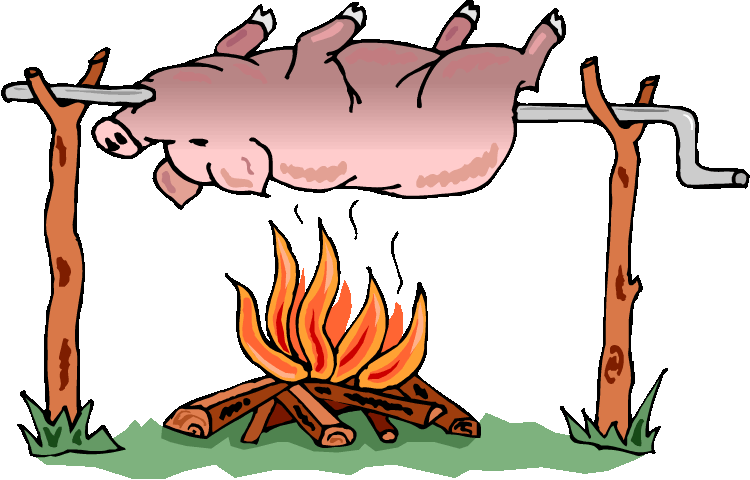 A few weeks ago a friend of a friend invited me to a pig roast. Having never attended one, I looked forward to what seemed like the perfect California outing: meeting new people and trying new food, all at a BBQ in February. Eating a pig that had been selected from a local, organic farm also sounded rather virtuous as far as meat-eating goes, and maybe in my heart of hearts I was thinking of the party as a kind of Omnivore’s Dilemma, Live. Besides, I like to say that I’ll try anything once, especially when it comes to food and I think that I might get an article out of it. I even started to string together a few premature sentences about The Pig Roast on the way over, dreamily trying out lines like “fork-tender localness”. (Michael Pollan I obviously ain’t.) Mental notebook at the ready, I pulled up to a trendy house in Los Feliz and quickly found myself among a crowd of strangers, each of us staring down at a charred animal the size of an eight-year old. The pig, laid out on its grill of cross hatched re-bar, turned a party of stoned hipsters into Lord of the Flies characters with edgier haircuts, everyone vaguely competitive and wondering what to do now.
A few weeks ago a friend of a friend invited me to a pig roast. Having never attended one, I looked forward to what seemed like the perfect California outing: meeting new people and trying new food, all at a BBQ in February. Eating a pig that had been selected from a local, organic farm also sounded rather virtuous as far as meat-eating goes, and maybe in my heart of hearts I was thinking of the party as a kind of Omnivore’s Dilemma, Live. Besides, I like to say that I’ll try anything once, especially when it comes to food and I think that I might get an article out of it. I even started to string together a few premature sentences about The Pig Roast on the way over, dreamily trying out lines like “fork-tender localness”. (Michael Pollan I obviously ain’t.) Mental notebook at the ready, I pulled up to a trendy house in Los Feliz and quickly found myself among a crowd of strangers, each of us staring down at a charred animal the size of an eight-year old. The pig, laid out on its grill of cross hatched re-bar, turned a party of stoned hipsters into Lord of the Flies characters with edgier haircuts, everyone vaguely competitive and wondering what to do now.
The one guy I knew, a trained chef who’d been appointed to preside over the cooking, had spent all day stoking the fire, turning the roast, and occasionally injecting citrus juice into the meat with a hypodermic needle. For the first time since morning, he just sort of stood there, absentmindedly waving away the sheets of smoke that rose from the drippings in the makeshift cinder block pit. The smell could knock you over, and some guest’s dogs ran around the yard doing a combination whimper and tail wag that I’d never seen before. The folks around me did the human equivalent: checking out the grill from various angles and reciting a litany of off color jokes, all porcine in nature. In an atmosphere of giddy hesitancy, it seemed as if the stretch between seeing the pig and actually eating it could have gone on forever. My friend the chef must have realized this, because after what felt like a decade of staring at the thing he grabbed a carving knife and cut its cheek off. A girl in heels and a sailor hat laughed the kind of laugh that signifies deep discomfort, and the guy next to her, who said “chicharrones” for about the fiftieth time that evening, struck me as suddenly sinister.
 Let me make it clear that I am neither squeamish nor sentimental. My mother often tells people, with perhaps a disproportionate sense of amusement, that I insisted on naming every lobster she ever brought home, going so far as to introduce them to my Barbies on the living room floor. Once the water boiled, however, I turned on a dime, selling out Peter or Justin or whoever that particular lobster was for a dish of melted butter and a cracking tool. Lobsters, you might argue, do not have faces, and are therefore harder to relate to. That the pig did have a face became instantly significant the moment that my friend cut its cheek off. (It seems no coincidence to me now that the word “cheek” refers to both a physical feature and a human personality trait.) Interestingly, it was the pig’s hips, those local, organic hips that really choked me up … but maybe that’s because I took an adjacent loin cut.
Let me make it clear that I am neither squeamish nor sentimental. My mother often tells people, with perhaps a disproportionate sense of amusement, that I insisted on naming every lobster she ever brought home, going so far as to introduce them to my Barbies on the living room floor. Once the water boiled, however, I turned on a dime, selling out Peter or Justin or whoever that particular lobster was for a dish of melted butter and a cracking tool. Lobsters, you might argue, do not have faces, and are therefore harder to relate to. That the pig did have a face became instantly significant the moment that my friend cut its cheek off. (It seems no coincidence to me now that the word “cheek” refers to both a physical feature and a human personality trait.) Interestingly, it was the pig’s hips, those local, organic hips that really choked me up … but maybe that’s because I took an adjacent loin cut.
 There were a few people, who, in the end, declined, but I think that most of us felt it had gone too far for that. I myself hadn’t yet given up on the line “fork-tender localness” and felt determined, despite my misgivings, to taste what I’ve heard other people rave about time and time again. So with a paper plate in hand, I waited behind a group of half-a-dozen partygoers who’d lined up beside the buffet table. Pork sandwiches, pork tacos, pork and rice and beans … all eaten quickly and standing up, amidst the catchy and highly explicit gangsta rap blaring from the speakers. (“I don’t give a mother fuck…better put them suckers up!”) Relieved that they could step away from the animal in its entirety, or perhaps just seduced by the smoky, primal smell, people began to stuff themselves. And yet, while sides like corn on the cob and salads remained relatively undiminished, mountains of meat piled up on the serving dishes, only to be conquered and piled up again. My friend the chef, who I saw very little of that evening, kept busy shredding, spicing and stewing up an endless variety of dishes, each one more fawned over than the last.
There were a few people, who, in the end, declined, but I think that most of us felt it had gone too far for that. I myself hadn’t yet given up on the line “fork-tender localness” and felt determined, despite my misgivings, to taste what I’ve heard other people rave about time and time again. So with a paper plate in hand, I waited behind a group of half-a-dozen partygoers who’d lined up beside the buffet table. Pork sandwiches, pork tacos, pork and rice and beans … all eaten quickly and standing up, amidst the catchy and highly explicit gangsta rap blaring from the speakers. (“I don’t give a mother fuck…better put them suckers up!”) Relieved that they could step away from the animal in its entirety, or perhaps just seduced by the smoky, primal smell, people began to stuff themselves. And yet, while sides like corn on the cob and salads remained relatively undiminished, mountains of meat piled up on the serving dishes, only to be conquered and piled up again. My friend the chef, who I saw very little of that evening, kept busy shredding, spicing and stewing up an endless variety of dishes, each one more fawned over than the last.
I admit that as the feeding frenzy subsided, the BBQ became more of a party than a pig-centric event. But when the general conversation did turn to how amazingly tender and complex the pork was, I realized that I couldn’t disagree … it very well might have been. The fact is that I have no idea what the meat actually tasted like, because I slathered enough garlic-cilantro sauce on mine to obliterate any other flavor. As soon as I’d finished my pork I went into Lady Macbeth mode, eating chocolate cookie after chocolate cookie, clinging to dessert like a security blanket. Somehow, in that house in the hills, I couldn’t concentrate on the taste of the thing. At a party designed to roast a local pig, where was the sense of reverence, of appreciation for the purity of what we were eating? I’m not saying that we should have said some sort of prayer for it … but maybe we should have said some sort of prayer for it? I felt like an outsider, and somewhere along the line I began to see the pig that way too. I’d driven to The Pig Roast through mid-city traffic, not a string of farms, and found that while in L.A. I like my meat dismembered: within city limits it’s just more natural that way.
After 12 years away from her home turf of Southern California, Agatha French returned to Los Angeles from Boston this past fall. She, and her boyfriend Ryan, are very much looking forward to the year round fruit.


